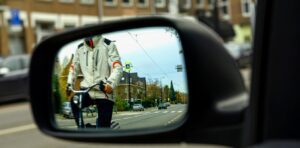Highway Code changes: what they mean and why they probably aren’t enough to change behaviour

In urban areas, pedestrians and cycle users are particularly at risk on the roads. In inner London between 2013 and 2015, 54% of all road traffic fatalities were pedestrians, and 17% were cycle users. In 2020, there were 141 cyclists killed on UK roads.
Updates to the Highway Code, which came into force on 29 January 2022 and apply to England, Scotland and Wales, attempt to address the dangers road travel poses to people walking, cycling and horse riding.
What stands out most is a new hierarchy of road users. This has been introduced to ensure those who can do the greatest harm have the greatest responsibility to reduce the danger or threat they may pose to others.
Pedestrians are at the top of this hierarchy. This means that, for example, cycle users should give way to pedestrians on shared paths, and drivers turning into or out of a road should give way to pedestrians waiting at the kerb to cross this road.
The UK government states that the Highway Code is essential reading – and the changes are a valuable step in the right direction. However, the question remains how far these changes will result in shifts in behaviour.
Freedom from fear
In my research, I have looked at how we can consider road safety through the lens of ethics – how we can live together without doing harm.
Here the writings of 18th century philosopher and politician Edmund Burke can help us. Burke used the phrase “the equality of restraint” when discussing the legal and social institutions required by a society. This means that the laws and other measures which seem to limit an individual’s freedom actually create an environment in which more people can live freely. Equal restraint ensures that my freedom does not restrict yours, and vice versa.
If we apply this to the Highway Code, the new hierarchy of road users, while placing more restraints on drivers, has the potential to create an environment in which other road users can enjoy freedom from fear. It makes clearer the responsibility of those with the ability to inflict most harm.
More considerate behaviour by those able to cause most harm would include greater compliance to speed limits, willingness to give way to other road users, and giving greater space to cycle users when overtaking.
Changing behaviour
The changes to the code could affect how people act on roads. For instance, pedestrians may assert their right to cross a side road and drivers may be willing to give way.
This requires awareness of the changes among drivers and vulnerable road users. The UK government intends to launch media campaigns starting in February 2022.
Changes in behaviour are also affected by how far all road users perceive the risk of prosecution for infringements. The changes introduce new advisory measures that are not legal requirements, but could be drawn upon in court proceedings.
How careful road users are in following the Highway Code may be influenced by whether courts of law are willing to make clear judgements supporting the hierarchy. In addition, wide publicity of such decisions by media networks will also encourage the adoption of this behaviour.
A behaviour change process requires a lot of steps, and there is little certainty that the changes in the Highway Code will lead away from the current “might is right” pattern of behaviour which sees motor vehicles take priority.
The range of steps that can be taken to change behaviour relating to public health is laid out in the “ladder of interventions” introduced by the Nuffield Council on Bioethics. The steps range from the least intrusive option – doing nothing or monitoring a situation – to the most intrusive: measures that entirely eliminate choice.
The Ladder of Interventions
The Ladder of Interventions shows the scale of public measures that can be taken, ranging from least to most intrusive.
Nuffield Council on Bioethics, CC BY
Arguably, the new Highway Code does little more than provide information. If it works well at making vulnerable road users safer then maybe, at best, it enables choice. This could mean that more people choose to walk and cycle for local trips because drivers have adapted their behaviour to reflect the ambitions of the Highway Code.
However, that is probably too optimistic as driver behaviour is likely to be subconscious and a matter of ingrained habit. Road users may consider the theoretical risk of successful prosecution too unlikely to influence their behaviour.
The changes to the Highway Code are marginal and limited, but they are a necessary step on any road to improve road safety for the most vulnerable. In reality, wide reaching changes – such as default 20mph speed limits in settlements, school street closures and the segregation of different modes of transport such as bicycles and cars are needed to truly create a hierarchy of road users.
What did you think of this article?
Great | Good | Meh | Weak






